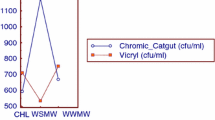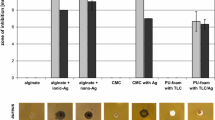Summary
The effects of three different dressings — two occlusive and one non-occlusive — on the bacterial flora of excised wounds in rats were studied. The number of colony forming units per gram of granulation tissue were significantly lower 4, 8 and 12 days postoperatively in wounds treated with a zinc medicated occlusive dressing compared with wounds treated with non-zinc medicated occlusive hydrocolloid dressing or wet-to-dry non-occlusive gauze dressing. The minimum inhibitory concentration (MIC) of zinc sulphate was determined on different strains of bacteria isolated from the wounds of rats and on strains isolated from humans. The most susceptible species isolated from both rat wounds and humans wereStreptococcus sp.,Staphylococcus aureus andEscherichia coli; whereas,Proteus andEnterococcus sp. had higher MIC-values.In vitro, the hydrocolloid dressing disclosed no antibacterial effects. If the practitioner prefers an occlusive dressing we believe, due to our animal andin vitro experiments, that the zinc medicated occlusive dressing will reduce the risk of wound infection in man.
Zusamenfassung
Die Wirkung von zwei verschiedenen Wundverbänden — zwei okklusiven und zwei nicht okklusiven — auf die bakterielle Besiedelung von Exzisionswunden wurde bei der Ratte untersucht. Bei Wunden, die mit einem zinkhaltigen Okklusivverband behandelt worden waren, war die Zahl der Koloniebildner pro Gramm Granulationsgewebe am 4., 8. und 12. postoperativen Tag signifikant geringer als bei Wunden, die mit einem Hydrokolloid-Okklusivverband ohne Zink oder feucht-trockenen Verbänden mit Wundgaze behandelt worden waren. Für verschiedene Bakterien, die aus den Wunden bei Ratten isoliert sowie für Stämme, die aus menschlichem Material angezüchtet worden waren, wurden die minimalen Hemmkonzentrationen von Zinksulfat bestimmt.Streptococcus sp.,Staphylococcus aureus undEscherichia coli von Rattenwunden wie auch die menschlichen Isolate dieser Spezies waren am empfindlichsten,Proteus undEnterococcus sp. wiesen höhere MHK-Werte auf. Der Hydrokolloid-Wundverband zeigtein vitro keinerlei antibakterielle Wirksamkeit. Wenn in der Praxis okklusive Wundverbände angewandt werden, ist nach unserer Erfahrung mit Tierversuchen undIn-vitro-Experimenten das Wundinfektionsrisiko beim Menschen durch Verwendung eines zinkhaltigen Wundverbandes geringer als bei Verbänden ohne Zink.
Similar content being viewed by others
References
Winter, G. D. Formation of the scar and the rate of epithelization of superficial wounds in the skin of the young domestic pig. Nature (London) 193 (1962) 293–294.
Söderberg, T., Hallmans, G., Stenström, S., Lobo, D., Pinto, J., Maroof, S., Vellut, C. Treatment of leprosy wounds with adhesive zinc tape. Lepr. Rev. 53 (1982) 271–276.
Söderberg, T., Nyström, Å., Hallmans, G., Hulten, J. Treatment of fingertip amputations with bone exposure. Scand. J. Plast. Reconstr. Surg. 17 (1983) 147–152.
Alvarez, O. M., Mertz, P. M., Eaglstein, W. H. The effect of occlusive dressings on collagen synthesis and re-epithelialization in superficial wounds. J. Surg. Res. 35 (1983) 142–148.
Eriksson, G. Comparison of two occlusive bandages in the treatment of venous leg ulcers. Br. J. Dermatol. 114 (1986) 227–230.
Linsky, C. B., Rovee, D. T., Dow, T. Effects of dressings on wound inflammation and scar tissue. In:Dineen, P., Hildick-Smith, G. (eds.) The surgical wound. Lea and Febiger, Philadelphia 1981, pp. 191–205.
Katz, S., McGinley, K., Leyden, J. J. Semipermeable occlusive dressings: effects on growth of pathogenic bacteria and reepithelialization of superficial wounds. Arch. Dermatol. 122 (1986) 58–62.
Mertz, P. M., Eaglstein, W. H. The effect of a semiocclusive dressing on the microbial population in superficial wounds. Arch. Surg. 119 (1984) 287–289.
Hallmans, G., Elmros, T. Zinc tape treatment of burns infected byPseudomonas aeruginosa. Scand. J. Plast. Reconstr. Surg. 14 (1980) 221–227.
Tengrup, I., Ågren, M. S., Bondeson, L., Forsgren, A., Hallmans, G., Söderberg, T. The effect of zinc and occlusion on the healing of open wounds. In:Mills, C. F., Bremner, I., Chester, J. K. (eds.). Proceedings of the 5th International Symposium on Trace Elements in Man and Animals-TEMA 5. Slough: Commonwealth Agricultural Bureaux 1985 pp. 87–89.
Hallmans, G. Absorption of topically applied zinc and changes in zinc metabolism during wound healing. Acta Derm. Venereol. 58 (1978) (Suppl. 80) 1–36.
Mertz, P. M., Marshall, D. A., Eaglstein, W. H. Occlusive wound dressings to prevent bacterial invasion and wound infection. J. Am. Acad. Dermatol. 121 (1985) 662–668.
Miller, R. G. Jr. Simultaneous statistical inference. McGraw-Hill, New York, 1966.
Varghese, M. C., Balin, A. K., Carter, M., Caldwell, O. Local environment of chronic wounds under synthetic dressings. Arch. Dermatol. 122 (1986) 52–57.
Madden, M. R., Finkelstein, J. L., Hefton, J. M., Yurt, R. W.: Optimal healing of donor site wounds with hydrocolloid dressings. In:Ryan, T. J. (ed.). An environment for healing: The role of occlusion. The Royal Society of Medicine, 1985, pp. 133–139.
Bolton; L., Oleniacz, W., Constantine, B., Kelliher, B. O., Jensen, D., Means, B., Rovee, D. Repair and antibacterial effects of topical antiseptic agentsin vivo. In:Maibach, H. I., Lowe, N. J. (eds.). Models in dermatology, vol. 2, Karger, Basel, 1985, pp. 145–158.
Lineaweaver, W., Howard, R., Soucy, D., McMorris, S., Freeman, J., Crain, C., Robertson, J., Rumley, T. Topical antimicrobial toxicity. Arch. Surg. 120 (1985) 267–270.
Gruber, R. P., Vistnes, L., Pardoe, R. The effect of commonly used antiseptics on wound healing. Plast. Reconstr. Surg. 55 (1975) 472–476.
McRipley, R. J., Whitney, R. R. Characterization and quantitation of experimental surgical-wound infections used to evaluate topical antibacterial agents. Antimicrob. Agents Chemother. 10 (1976) 38–44.
Robson, M. C., Heggers, J. P. Surgical infection. I. Single bacterial species or polymicrobic in origin? Surgery 65 (1969) 608–610.
Lookingbill, D. P., Miller, S. H., Knowles, R. C. Bacteriology of chronic leg ulcers. Arch. Dermatol. 114 (1978) 1765–1768.
Paetzold, O. H., Wiese, A. Experimentelle Untersuchungen über die antimikrobielle Wirkung von Zinkoxid. Arch. Derm. Res. 253 (1975) 151–159.
Kasahara, M.;Anraku, Y. Succinate oxidase and NADH-oxidase systems ofEscherichia coli membrane vesicles mechanism of selective inhibition of sytems by zinc ions. J. Biochem. 76 (1974) 967–976.
Golub, E. E., Cheruka, J., Boosz, B., Davis, C., Malamud, D. A comparison of bacterial aggregation induced by saliva, lysozyme and zinc. Infect. Immun. 48 (1985) 204–210.
Author information
Authors and Affiliations
Rights and permissions
About this article
Cite this article
Söderberg, T., Hallmans, G., Ågren, M. et al. The effects of an occlusive zinc medicated dressing on the bacterial flora in excised wounds in the rat. Infection 17, 81–85 (1989). https://doi.org/10.1007/BF01646881
Received:
Accepted:
Issue Date:
DOI: https://doi.org/10.1007/BF01646881




